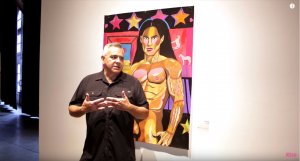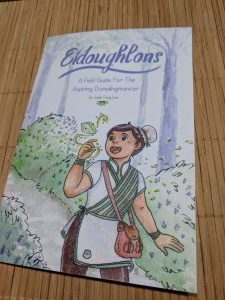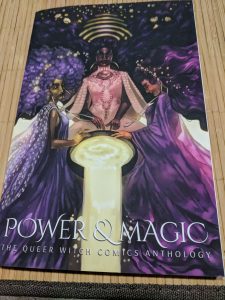On August 7, 2017, the 2SQTILGBIPOC Alliance and the Anti-Oppression Network hosted the 2SQTILGBIPOC Pride Celebration in the Carnegie Community Centre Theater Room, located in the Downtown Eastside area of Vancouver. This celebration was organized as an alternative Pride event for Two-Spirit, Queer, Transgender, Intersex, Lesbian, Gay, and Bisexual people of colour (2sqtilgbipoc Alliance, 2017), and for people who do not feel safe attending the Vancouver Pride Parade (due to police involvement; Newton, 2017). One attendee of the celebration, vanessa bui, pointed to the overrepresentation of white performers and participants at other Pride celebrations as part of their motivation to attend an alternative, more inclusive Pride event (in Newton, 2017).
Bailey (2014) theorizes space as a “cultural production” (p. 490), and people use behaviour to transform and reconfigure space. If Pride Parades actively create Queer streets rather than merely turn streets Queer (Bell and Valentine, 1995, in Begonya, 2009), then the overrepresentation of white people described by bui, as well as the police attendance at the Vancouver Pride Parade, can be examples of presence and behaviour that creates a space that socially excluded group members feel uncomfortable or unsafe in. These theories can be utilized to explain why groups, such as the 2SQTILGBIPOC Alliance and the Anti-Oppression Network, consider the need for celebrations to “reclaim Pride” (2sqtilgbipoc Alliance, 2017).
Furthermore, according to research and theory by Greensmith and Giwa (2013), Canadian Pride celebrations between 2009 and 2012 have neglected to acknowledge the diversity of Queer Canadians, and instead focus on White and colonized Queer activism, which “reinforce and normalize homonormativity” (p. 133). While heteronormativity is the normalization of heterosexuality in human society and its members (Warner, 1991), homonormativity is the creation of a “depoliticized gay culture anchored in domesticity and consumption” (Duggan, 2002, p. 179, in Greensmith & Giwa, 2013). Homonormativity is vital for the development of homonationalism (Puar, 2007), which reinforces white normativity and justifies violence against and exclusion of racialized and Indigenous people. Both homonormativity and homonationalism are why some Queer activist groups refused to participate in the 2017 Vancouver Pride Parade, such as Salaam, a Queer Muslim support group (Bedry, 2017).
For Imtiaz Popat, the founder of Salaam and a co-organizer of the 2SQTILGBIPOC Pride Celebration, locating the 2SQTILGBIPOC Pride event in Vancouver’s Downtown Eastside is significant:
Because people [in the Downtown Eastside]–Two-Spirit, people who live down here, who are people of colour–don’t fit into the West End. They don’t fit into the East Side either, so [it’s important] to hold a space here as a safer space. (quoted in Newton, 2017)
Bailey (2014) argues that people use and alter space to escape “spatial marginalization,” a term that describes the supposedly public space that marginalized groups members are commonly refrained from accessing. For 2SQTILGBIPOC people, the 2SQTILGBIPOC Pride Celebration transformed the Carnegie Community Centre Theater Room to escape the spatial marginalization usually experienced in Vancouver’s Downtown Eastside.
References
2sqtilgbipoc Alliance. (2017). In Facebook. Retrieved November 5, 2017, from https://www.facebook.com/events/678129855707535/
Agathangelou, A. M., Bassichis, M. D., & Spira, T. L. (2008). Intimate investments: Homonormativity, global lockdown, and the seductions of empire. Radical History Review, 100, 120-43.
Anguksuar/Richard LaFortune. (1997). A postcolonial colonial perspective on western [mis]conceptions of the cosmos and the restoration of Indigenous taxonomies. Two-Spirit people: Native American gender identity, sexuality, and spirituality. S. Jacobs, W. Thomas, & S. Lang (Eds.). Chicago: University of Illinois Press.
Bailey, M. M. (2014). Engendering space: Ballroom culture and the spatial practice of possibility in Detroit. Gender, Place & Culture, 21(4), 489-507.
Bedry, D. (2017, May 18). Uniformed police will march in Vancouver’s Pride parade. Xtra. Retrieved November 7, 2017, from https://www.dailyxtra.com/uniformed-police-will-march-in-vancouvers-pride-parade-73525
Begonya, E. (2009). Identities, sexualities, and commemorations: Pride parades, public space and sexual dissidence. Anthropological Notebooks, 15(2), 15-33.
Bell, D. & Valentine, G. (1995). Mapping desire. New York: Routledge.
Driskill, Q-L. (2010). Doubleweaving Two-Spirit critiques: Building alliances between Native and Queer studies. GLQ: A Journal of Lesbian and Gay Studies, 16(1-2), 69-92.
Duggan, L. (2002). The new homonormativity: The sexuality politics of neoliberalism. Materializing democracy: Toward a revitalized cultural politics. R. Castronovo & D. Nelson (Eds.). Durham, NC: Duke University Press.
Greensmith, C. & Giwa, S. (2013). Challenging settler colonialism in contemporary Queer politics: Settler homonationalism, pride Toronto, and Two-Spirit subjectivities. American Indian Culture and Research Journal, 37(2), 129-48.
Newton, R. (2017, Aug 8). How this Pride event celebrated Queer and Trans people of colour in Vancouver. Xtra. Retrieved November 5, 2017, from https://www.dailyxtra.com/how-this-pride-event-celebrated-queer-and-trans-people-of-colour-in-vancouver-77796
Puar, J. K. (2007). Terrorist assemblages: Homonationalism in Queer times. I. Grewal, C. Kaplan, & R. Wiegman (Eds.). Durham, NC: Duke University Press.
Warner, M. (1991). Introduction: Fear of a Queer planet. Social Text, 29, 3-17.


